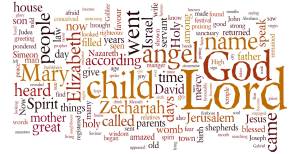The third of the 2014 Newman Advent Seminars explored the traditions concerning the nativity that developed following the the New Testament accounts.

During the session we were introduced to extracts from three apocryphal (non biblical) accounts of the nativity. For those who wanted more information and to read the texts further, you will find below some links to online editions of them.
Texts used:
The Protevangelium of James (also known as the Infancy Gospel of James)
- Dated mid to late second century.
- The first reference to it is by Origen (Commentary of Matthew 10:17) in the early third century.
- Earliest surviving manuscript: 3-4th century, Papyrus Bodmer V (Syriac)
Online text – http://www.asu.edu/courses/rel376/total-readings/james.pdf
Mark Goodacre has done an excellent introduction to this text in one of his NT Pod podcasts
See also the wordcloud and introductory discussion of the Protevangelium of James posted earlier.
The Gospel of Pseudo-Matthew (sometimes known as The Infancy Gospel of Matthew)
- Variously dated to between 7-9th century, but also 600-625 (see Gijsel and R. Beyers, 1997)
- Prefaced by a letter purported to be written by Jerome (though unlikely)
- Earliest surviving manuscript 11th century (Latin)
Online text – http://gnosis.org/library/psudomat.htm
The Arabic Gospel of the Infancy (also known as the First Gospel of the Infancy of Jesus Christ)
- Dated to 5-6th century
- Earliest surviving manuscripts: Early medieval (Arabic)
Online text – http://www.ccel.org/ccel/schaff/anf08.vii.xi.html
Further information:

This is a helpful non-specialist introduction to the infancy narratives (both New Testament and apocryphal) written by John Gayford (St Mary, East Grinstead).
For fuller information, including more up to date translations, refer to J.K. Elliott’s The Apocryphal New Testament: A Collection of Apocryphal Christian Literature in English Translation Based on M.R. James
The characters and themes developed in the apocryphal tradition continue to this day…






